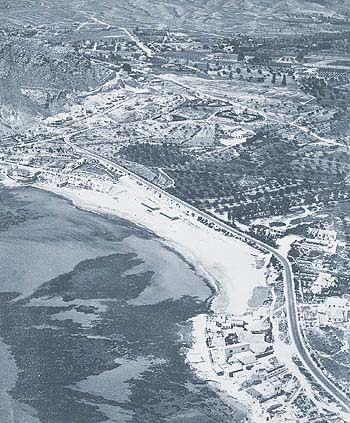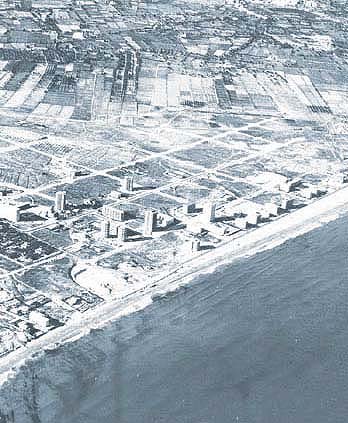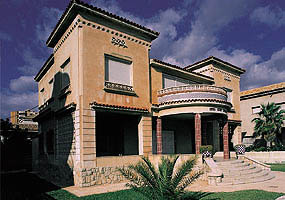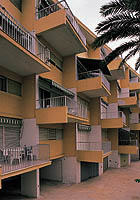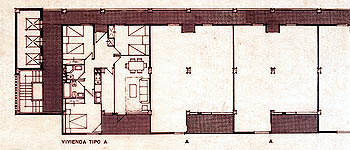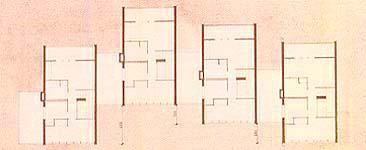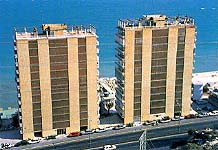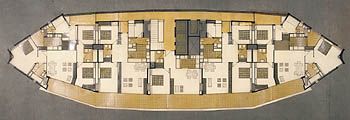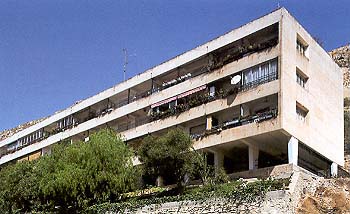|
Antecedentes
Si nos situamos en Alicante a mediados de los años 50, podemos
considerar la evolución en paralelo de dos procesos que en principio no
tendrían porqué estar relacionados entre sí.
Por un lado la arquitectura moderna está reiniciando, con los titubeos
propios de todo comienzo, su camino en la historia de la arquitectura
alicantina, con un pequeño y lógico desfase -en torno a un lustro-
respecto a lo que estaba ocurriendo a nivel nacional en los grandes focos
de cultura y de producción arquitectónica. Todo ello tras el drástico
paso atrás que supuso la guerra civil y la imposición por parte de la
dictadura de su nueva arquitectura neoimperialista.
Por otra parte el mejor litoral de la ciudad de Alicante -el litoral
norte, que comprende la accidentada bahía de la Albufereta y la
rectilínea y llana playa de San Juan- comienza tímidamente a edificarse
(1 y 2). También en este caso podemos y debemos hablar de un volver a
empezar, ya que el primer intento de urbanizar esta franja del litoral se
había producido en tiempos de la República.
A comienzo de los años 30, Indalecio Prieto al frente del ministerio
de Obras Públicas ya había concebido la zona que va desde la Serra
Grossa hasta el cauce del río Seco de El Campello como apropiada para el
uso vacacional de cara al turismo interior. Fruto de todo ello en el año
1933 se declara la zona como de utilidad pública, se promulga una ley
para la construcción de la carretera de unión de Alicante con la playa
de San Juan como complemento de la línea de ferrocarril ya existente, y
se convoca un concurso nacional de anteproyectos para la construcción de
una ciudad satélite de Alicante -que se denominaría "Ciudad
Prieto"- y que debería constituir un foco de atracción turística
que contara con hotel, balneario, campo de golf y campos de deporte.
El concurso es ganado por Pedro Muguruza, que en su proyecto utiliza
técnicas urbanísticas avanzadas para la época -zonificación, plan de
etapas, estudio de equipamientos y red viaria- frente a una solución más
formalista del arquitecto alicantino Gabriel Penalva fundamentada en unas
alineaciones de gran potencia geométrica pero que no dejan clara su
relación con el entorno en que se asientan. Tras el cambio en el gobierno
de la República en 1934 en primer lugar, y el fratricida conflicto
bélico de 1936 a 1939 en segunda instancia, el proyecto ganador queda
prácticamente paralizado hasta finales de los años 50.
Primeros indicios de modernidad
Sin embargo como la demanda no es excesiva, van apareciendo durante los
años 40 y primeros 50 pequeñas edificaciones que se van apropiando sin
aparente competencia de la primera línea de playa, aunque este proceso se
produce en mayor medida a partir de que el ferrocarril alcanza la costa,
hecho que ocurre cerca del linde con el término municipal de El Campello
(1). En aquellos tiempos en que el medio de locomoción propio era un
lujo, la vía del tren -hoy importante barrera- suponía el mejor acceso
posible a la residencia estival.
Los casticismos en el mejor de los casos (3), o construcciones
rutinarias, todavía eran las imperantes al finalizar la década de los
50, apropiándose de zonas privilegiadas del litoral (2).
Aparecen poco a poco los primeros equipamientos hoteleros. En el
pequeño hostal "San Juan", proyectado en 1955 por Juan Antonio
García Solera podemos entrever los primeros atisbos de modernidad en el
ámbito de estudio. Es la primera obra reseñable de este arquitecto que
se había titulado en la escuela de Madrid dos años antes, y que con este
proyecto indaga en el lenguaje moderno no de manera radical, sino a
través de las formas, materiales y elementos que aporta la arquitectura
tradicional mediterránea. Los muros blancos y la teja árabe definen unos
volúmenes nítidos en el que el paño trapezoidal aparece constantemente
debido a la inclinación de los planos de cubierta. Aunque la voluntad
proyectual supera en este caso al edificio construido en un entorno hostil
frente a la vía del tren, las tensiones horizontales del dibujo
potenciadas por la utilización de fuertes manchas de tinta negra, y el
contrapunto de la piedra y del ritmo vertical de la chimenea convierten a
este edificio en nuestro punto de partida (4).
.../...
|
Background
If we situate ourselves in the Alicante of the mid
fifties, it is possible to consider the parallel evolution of two
processes which initially had no reason to be inter-related.
On the one hand, modern architecture was being
reinitiated, with the natural hesitancy of any beginning, continuing the
historical line of the architecture of Alicante, with a small and logical
phase lag -around a five-year period- in respect to what was at that time
occurring on a national level in the major focus points of culture and of
architectonic production. All of this after the drastic step backwards
brought on by the civil war and the imposition on the part of the
dictatorship of a new neo-imperialist architecture.
On the other hand, the prime coastal section of the
city of Alicante -the north coast, which includes the broken bay of the
Albufereta and rectilinear and flat beach of San Juan- timidly began to
see construction (1 & 2). Also in this case we can and should make
mention of a new beginning, as the first attempts to develop this section
of the coast had been undertaken in the times of the Republic.
At the beginning of the thirties, Indalecio Prieto, in
charge of the Ministry of Public Works, had already envisioned the zone
that runs from the Serra Grossa up as far as the Río Seco (dry
river) of El Campello as being appropriate for holiday use with a
view to domestic tourism. As a result of all this, in the year 1933 the
area was zoned for public use, and a law was passed approving the
construction of a road to join Alicante with San Juan Beach as
complimentary to the already existent rail line. An invitation to tender
for the presentation of preliminary projects for the construction of a
satellite city to Alicante was announced on a national level -the city was
to be called "Ciudad Prieto"- and it was to constitute a focus
of tourist attraction that would include a hotel, spa, golf course and
athletic installations.
The invitation to tender was awarded to Pedro Muguruza,
who in his project utilised urban techniques that were advanced for that
time -zoning, phase planning, study of installations and network of roads,
over a more formalist solution presented by the Alicante architect Gabriel
Penalva, which was based on high power geometrical alineations, but which
provided no clear relation with the environment in which they were to be
implanted. After, first of all, the change in the Republican government in
1934, and secondly, the fratricidal military conflict from 1936 to 1939,
the project which had been awarded the commission remained practically
paralysed until the beginning of the fifties.
First indications of modernity
Demand, however, was not excessive, and small
structures that began to appropriate the front line of the beach with no
apparent competition began to appear in the 40s and at the beginning of
the 50s, although this process was accelerated when the rail lines reached
the coast near the boundary with the municipality of El Campillo (1). In
those times it was a luxury to have one’s own means of transportation,
and the train -today an important barrier- represented the best possible
access to the summer residential area.
The traditional structures in the best of cases (3), or
routine constructions, were still predominant up until the end of the
fifties, and appropriated the privileged areas of the coast (2).
Little by little the first hotel installations began to
appear. In the small hotel "San Juan", designed in 1955 by Juan
Antonio García Solera it is possible to appreciate the first signs of
modernity as far as design is concerned. This is the first project we can
point out by this architect who had earned his degree two years before in
the school of Madrid, and with this project he enters into the modern
language not in a radical manner, but through the forms, materials and
elements provided by the traditional Mediterranean architecture. The white
walls and the Arabic tiling define the clear sharp volumes in which the
trapezoidal panel appears constantly due to the inclination of the planes
of the roof. Although intention in the project design exceeds in this case
the actual building that was constructed in a hostile environment in front
of the train tracks, the horizontal tensions of the drawing potentiated by
the utilisation of heavy black ink, and the counterpoint of the stone and
the vertical rhythm of the chimney make this building our starting point (4).
.../...
|
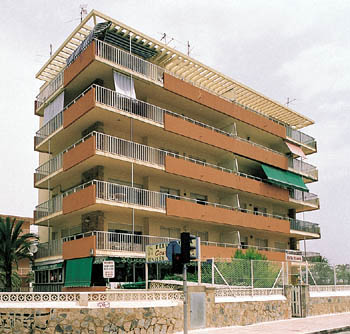
Miguel López González. Apartamentos y
restaurante para la constructora del Sudeste S.L. 1958, playa San Juan.
Imagen de los bloques de viviendas / Miguel López
González. Apartments and restaurant for Constructora Sudeste S.L. 1958,
San Juan Beach. View of blocks of flats.
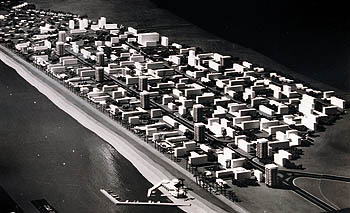
11. Juan Guardiola Gaya. Plan de primer polígono
de la playa de San Juan. 1959. Vista general de la maqueta / Juan
Guardiola Gaya. Plan for the first housing estaate development in San Juan
Beach. 1959. General view of the scale model.
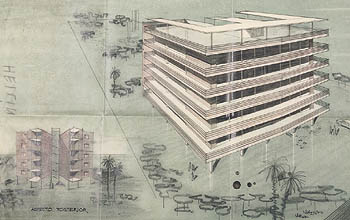
17. Miguel López González. Apartamentos para
Francisco Hellin, 1962. Perspectiva / Miguel López
González. Apartments for Francisco Hellin, 1962. Perspective drawing.
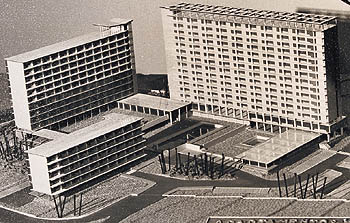
20. Juan Antonio García Solera. Urbanización
Maralic, 1963. Maqueta /
Juan Antonio García Solera.
Housing development Maralic, 1963. Scale model.
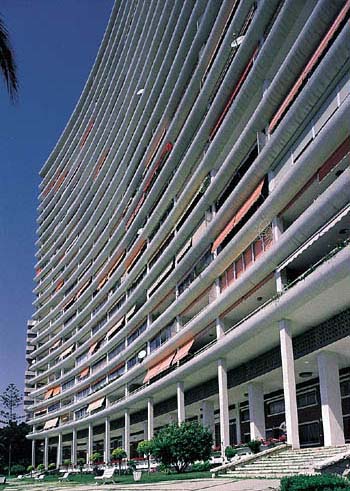
29.
Juan Guardiola Gaya. Urbanización La Chicharra. 1965. La Albufereta / Juan
Guardiola Gaya. Housing development La Chicharra. 1965. La Albufereta.
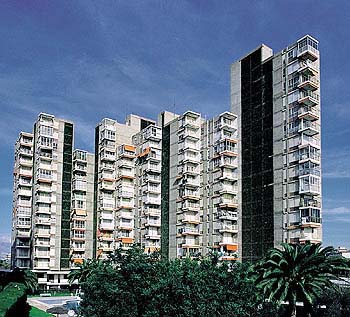
44. Juan Antonio García Solera. Urbanización Las
Torres, 1968. La Albufereta. Vista desde el mar / Juan
Antonio García Solera. Housing development Las Torres, 1968. La
Albufereta. View fron the sea.
|
